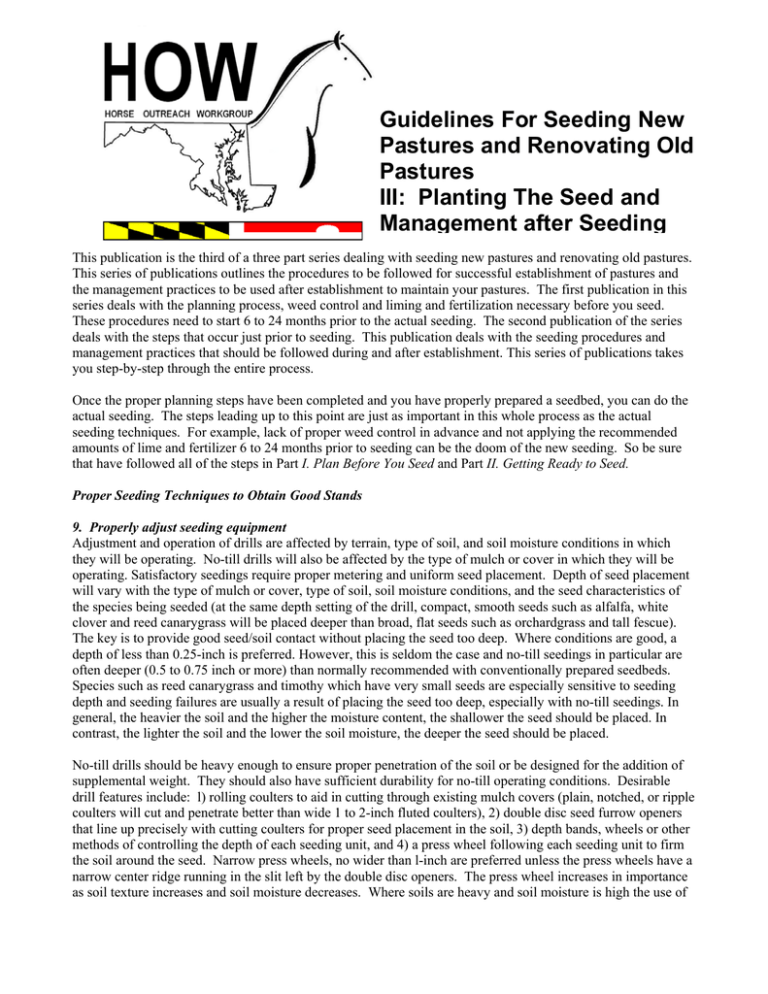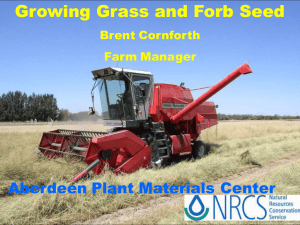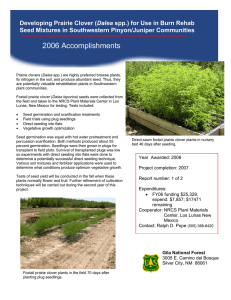Guidelines For Seeding New Pastures and Renovating Old Pastures
advertisement

Guidelines For Seeding New Pastures and Renovating Old Pastures III: Planting The Seed and Management after Seeding This publication is the third of a three part series dealing with seeding new pastures and renovating old pastures. This series of publications outlines the procedures to be followed for successful establishment of pastures and the management practices to be used after establishment to maintain your pastures. The first publication in this series deals with the planning process, weed control and liming and fertilization necessary before you seed. These procedures need to start 6 to 24 months prior to the actual seeding. The second publication of the series deals with the steps that occur just prior to seeding. This publication deals with the seeding procedures and management practices that should be followed during and after establishment. This series of publications takes you step-by-step through the entire process. Once the proper planning steps have been completed and you have properly prepared a seedbed, you can do the actual seeding. The steps leading up to this point are just as important in this whole process as the actual seeding techniques. For example, lack of proper weed control in advance and not applying the recommended amounts of lime and fertilizer 6 to 24 months prior to seeding can be the doom of the new seeding. So be sure that have followed all of the steps in Part I. Plan Before You Seed and Part II. Getting Ready to Seed. Proper Seeding Techniques to Obtain Good Stands 9. Properly adjust seeding equipment Adjustment and operation of drills are affected by terrain, type of soil, and soil moisture conditions in which they will be operating. No-till drills will also be affected by the type of mulch or cover in which they will be operating. Satisfactory seedings require proper metering and uniform seed placement. Depth of seed placement will vary with the type of mulch or cover, type of soil, soil moisture conditions, and the seed characteristics of the species being seeded (at the same depth setting of the drill, compact, smooth seeds such as alfalfa, white clover and reed canarygrass will be placed deeper than broad, flat seeds such as orchardgrass and tall fescue). The key is to provide good seed/soil contact without placing the seed too deep. Where conditions are good, a depth of less than 0.25-inch is preferred. However, this is seldom the case and no-till seedings in particular are often deeper (0.5 to 0.75 inch or more) than normally recommended with conventionally prepared seedbeds. Species such as reed canarygrass and timothy which have very small seeds are especially sensitive to seeding depth and seeding failures are usually a result of placing the seed too deep, especially with no-till seedings. In general, the heavier the soil and the higher the moisture content, the shallower the seed should be placed. In contrast, the lighter the soil and the lower the soil moisture, the deeper the seed should be placed. No-till drills should be heavy enough to ensure proper penetration of the soil or be designed for the addition of supplemental weight. They should also have sufficient durability for no-till operating conditions. Desirable drill features include: l) rolling coulters to aid in cutting through existing mulch covers (plain, notched, or ripple coulters will cut and penetrate better than wide 1 to 2-inch fluted coulters), 2) double disc seed furrow openers that line up precisely with cutting coulters for proper seed placement in the soil, 3) depth bands, wheels or other methods of controlling the depth of each seeding unit, and 4) a press wheel following each seeding unit to firm the soil around the seed. Narrow press wheels, no wider than l-inch are preferred unless the press wheels have a narrow center ridge running in the slit left by the double disc openers. The press wheel increases in importance as soil texture increases and soil moisture decreases. Where soils are heavy and soil moisture is high the use of a press wheel can actually be detrimental. In these cases it may be desirable to leave the seed furrow open to allow the seed to germinate and grow. If the slit is closed with a press wheel, the seed may be covered too deeply and be unable to emerge. 10. Seed at the Proper Time Late winter is the preferred time for seeding legumes into an existing productive stand of grass. These seedings should be made as early as possible to minimize grass and weed competition. In central Maryland and southeastern Pennsylvania this would be during the period from late February to late March. Dates for the Delmarva Peninsula and southern Maryland would be somewhat earlier and the mountains of western Maryland and western and northern Pennsylvania somewhat later. Early seedings tend to be more competitive and result in better stands than seedings made later in the spring. Late winter seedings can be made as "frost seedings" without the use of a drill. Frost seeding should be done when the soil surface is honeycombed with ice crystals. The alternate freezing and thawing that occurs during late winter (freezing during the night, thawing during the day) plus rain action usually cover the seed to about the right depth. This works best when grass stands are thin or where the grass sward was heavily grazed during fall and early winter. On well-drained soils where puddling is not a problem, the trampling effect of the grazing animal may actually improve seed/soil contact but animals should be removed when germination of the seeded legume begins. Frost seedings have worked particularly well with red clover. Late summer is the preferred time for seeding if the existing species are to be eliminated and both the grass and legume must be seeded. For central and southern Maryland and the Delmarva Peninsula, this would be the period from approximately August 10 to September 10. For the mountains of western Maryland, the corresponding dates would be August 1 to September 1. Soil moisture can frequently be a limiting factor with late summer seedings. Two applications of a contact herbicide can be effective in conserving soil moisture, especially when precipitation occurs between the two applications. Seeding should be timed with rainfall so that adequate soil moisture is available at the time of seeding. 11. Seeding Rates Pasture seeding rates are higher than hay seeding rates to provide a denser sod for grazing. This is especially true for horse pastures. Table 1 lists seeding rate recommendations for various choices and mixtures based on soil type. 12. Management During Establishment When all of the old vegetation was killed either with herbicide or by tillage, new seedings should not be grazed until the seedlings have developed sufficient root systems to prevent uprooting when grazed. One approach is to allow the new plants to grow to 10-12 inches, mow to a height of 3-4 inches, allow to regrow to 10-12 inches again and mow to 3-4 inches a second time. After the second mowing, let the plants again grow to 10-12 inches. By this time the plants should be ready for grazing so allow the animals to graze them down to 3-4 inches. Most forage grasses and legumes regrow from crown buds and are usually not seriously damaged by cutting. However, clipping too frequently can reduce seedling development as well as forage yields the following year. So don’t overdo it. To test for adequate root development, grasp a handful of plant material and tug on it. If you can easily pull it out of the ground, the root system is not sufficiently developed to prevent uprooting by the animals as they graze. If this is the case, another mowing and regrowth cycle is needed. Be sure not to graze the plants lower than 3-4 inches and graze only when the soil surface is dry and firm. Never graze new stands during wet periods, especially on tilled seedbeds. If it is feasible to harvest the spring growth as hay, this is another option for allowing plants to develop a sufficient root system before grazing. The spring growth is allowed to grow to the late boot/early heading stage and then harvested as hay. Once the regrowth following hay harvest is 10-12 inches tall, grazing can begin. Weeds often invade new seedings and the stand may be reduced if they are not controlled. Clipping, in addition to being a good management practice for developing root systems during establishment, will also reduce competition of weeds with the new grass and legume seedlings. But it should not be done too early. If clipped too early, only the tops of the weeds will be removed, leaving active buds on the stubble to produce new branches and even more competition. Sufficient weed growth should be allowed so that most active buds are removed when the new seeding is clipped. Do not allow weeds to produce seed. Even though the seedlings from late summer seedings may make considerable growth during the late summer and fall period, they should not be cut or grazed. Clipping or grazing seedling stands weakens the plants and results in greater susceptibility to winterkilling. Grazing or clipping of new spring seedings should end 4 to 6 weeks prior to the average killing frost date to allow for buildup of reserves for winter. Avoid grazing of new stands during wet periods, especially on tilled seedbeds. If late winter overseeding of grasses or legumes was made to rejuvenate a weak stand without using herbicide to suppress competition, it is usually necessary graze and/or mow the pasture one or more times to reduce competition to the young seedlings during the establishment period. The old plants can provide substantial competition to the young seedlings if not periodically grazed or mowed. The pasture can be grazed until the animals start eating the young seedlings. At that point the animals should be removed to allow further establishment of the seedlings. Length of the deferred period of grazing varies with growing conditions and species, with shorter periods feasible under favorable growing conditions or with the more rapidly growing species. Grazing and rest/establishment cycles should be repeated as necessary until the seedlings became well enough established to withstand grazing as described above. New seedings should be monitored for slugs, insect and disease problems at least weekly for the first 6 to 8 weeks. Pasture producers often fail to monitor new seedings and it is difficult, if not impossible, to determine the cause of seeding failures when you don’t know what happened during that 6- to 8- week period following seeding. Depending upon the species seeded, it can take a year or more to establish a vigorous stand. The producer must be patient and use management practices that will help the forage seedlings to become established. 13. Rotationally Graze After Establishment Rotational grazing assists in maintaining productive forage stands. In comparison with continuous grazing, rotational grazing enables the producer to better match grazing to the growth habit of the forage, condition of the pasture and animal needs. Rotational grazing uses relatively short periods of intensive grazing followed by a relatively long period of recovery. This system provides more effective and complete consumption of the forage with less waste by trampling, fouling or selective grazing. Rotational grazing favors legume persistence and higher animal output per acre compared to continuous grazing. It also allows for harvesting of excess forage as hay or silage during the flush of spring growth. The hay or silage can then be used during periods when forage is not available for grazing due to drought, winter conditions, etc. More detailed information on how to set up a rotational grazing system is available from your local Soil Conservation District or Maryland Cooperative Extension office. 14. Fertilize Annually Economic studies have shown that liming and fertilizing forages are profitable. Annual maintenance applications of fertilizer help to protect the investment made in renovating the pasture. Follow the maintenance fertilizer recommendations that came with the results of the soil test taken prior to seeding. Each pasture field should be retested every two to three years. A periodic soil test is the best guide to determining the soil pH and fertility status and to see if the soil fertility maintenance program is adequate. SUMMARY – Manage, Manage, Manage It is often surprising just how productive some old worn-out pastures can become. But once this initial improvement has been made, there is too often a tendency to slip back into old practices of overgrazing and little or no fertilizer applied, and soon the pastures are back to weeds and low productivity. After a new seeding or renovation seeding it is necessary to follow up with good forage management practices to realize continuing benefits from a new or renovation seeding. There are no shortcuts and no substitutes for good management practices to maintain the results achieved through seeding. Table 1. Recommended Hay and Pasture Seeding Rates for New Stands Species and mixture recommendations according to soil type and primary use Seeding rate (lb/acre) I. Deep, well-drained fertile soils A. Primarily for hay, silage or greenchop Alfalfa alone Alfalfa and Late maturing orchardgrass or Timothy or Smooth bromegrass Alfalfa and Reed canarygrass Red clover alone Red clover and Timothy or Late maturing orchardgrass Birdsfoot trefoil alone (Upright or European-type varieties – Cascade, Viking, Leo, etc.) Birdsfoot trefoil and Timothy or Late maturing orchardgrass or Reed canarygrass Orchardgrass alone Reed canarygrass alone Smooth bromegrass alone Timothy alone 15-20 8-12 2-6 4-6 6-8 8-10 8-10 10-12 6-8 4-6 4-6 7-10 5-8 4-6 2-4 8-10 10 12-14 12-15 8-10 B. Primarily for pasture Orchardgrass and Alfalfa or Red clover + white (ladino-type) clover or Birdsfoot trefoil (prostrate and semi-erect Empire type varieties – AU-Dewey, Carroll, Dawn, Fergus, Norcen, etc.) Orchardgrass + perennial ryegrass and Red clover + white (ladino-type) clover 8-10 8-10 6-8 + 1 5-8 8-10 + 3-5 6-8 +1-2 Orchardgrass + Kentucky bluegrass and White (ladino-type) clover (especially suited for horse pasture) 8-12 + 2-4 1 Tall fescue and Alfalfa or Red clover + white (ladino-type) clover or Birdsfoot trefoil 10-15 8-10 6-8 + 1 5-8 Smooth bromegrass and Alfalfa or Red clover + white (ladino-type) clover or Birdsfoot trefoil 8-10 8-10 6-8 + 1 5-8 II. Wet or Poorly Drained Soils A. Primarily for hay, silage or greenchop Red clover + alsike clover and Timothy or Reed canarygrass Birdsfoot trefoil and Timothy or Reed canarygrass or Late maturing orchardgrass Birdsfoot trefoil alone Reed canarygrass alone 6-8 + 2-4 4-6 8-10 5-8 4-6 8-10 2-4 7-10 12-14 B. Primarily for pasture Tall fescue and Birdsfoot trefoil or Alsike + white (ladino-type) clover Reed canarygrass and Birdsfoot trefoil or Alsike + white (ladino-type) clover Tall fescue alone Reed canarygrass alone 10-15 5-8 2-4 + 1-2 8-10 5-8 2-4 + 1-2 15-20 12-14 III. Droughty Soils: Sandy, Shallow, Steep, Shaly or Gravely A. Primarily for hay, silage or greenchop Alfalfa alone Alfalfa and Late maturing orchardgrass or Smooth bromegrass or Alfalfa and Reed canarygrass Red clover alone Red clover and Late maturing orchardgrass or Reed canarygrass Birdsfoot trefoil alone 15-20 8-12 2-6 6-8 8-10 8-10 10-12 6-8 4-6 8-10 7-10 Birdsfoot trefoil and Late maturing orchardgrass or Reed canarygrass 5-8 2-4 8-10 B. Primarily for Pasture Tall fescue and Alfalfa or Red clover or Birdsfoot trefoil Orchardgrass and Alfalfa or Red clover or Birdsfoot trefoil Perennial ryegrass and Alfalfa or Red clover or Birdsfoot trefoil Switchgrass Big bluestem Caucasian bluestem Eastern gamagrass Indiangrass 10-15 8-10 6-8 5-8 8-10 8-10 6-8 5-8 12-15 8-10 6-8 5-8 8-10 (PLS)* 8-10 (PLS) 3-4 (PLS) 8 (PLS) 6-8 (PLS) drilled 12-15 (PLS) broadcast * PLS = pure live seed = (% germination x % pure seed) ÷ 100. For more information on horse manure management and other soil conservation and water quality practices, contact you local Soil Conservation District. For more information contact your local Soil Conservation District/ Natural Resources Conservation Service/ (SCD/ NRCS) office or county Maryland Cooperative Extension (MCE) office. Addresses and phone numbers can be found at http://www.mda.state.md.us/resource_conservation/technical_assistance/index.php , http://www.md.nrcs.usda.gov/contact/directory or http://extension.umd.edu or check the listing County Government for SCD/MCE or US Government, Department of Agriculture for NRCS of the phone book blue pages. The Horse Outreach Workgroup was established to provide information to horse owners on pasture and manure management issues. Technical assistance is available from local county Soil Conservation Districts/Natural Resource Conservation Service and the Maryland Cooperative Extension office. The workgroup consists of representatives from local Soil Conservation Districts, Maryland Department of Agriculture, Natural Resource Conservation Service, Cooperative Extension, University of Maryland, the Equiery, and the Maryland Horse Council. The Maryland Department of Agriculture’s Office of Resource Conservation provides coordination for the workgroup. January 2007



